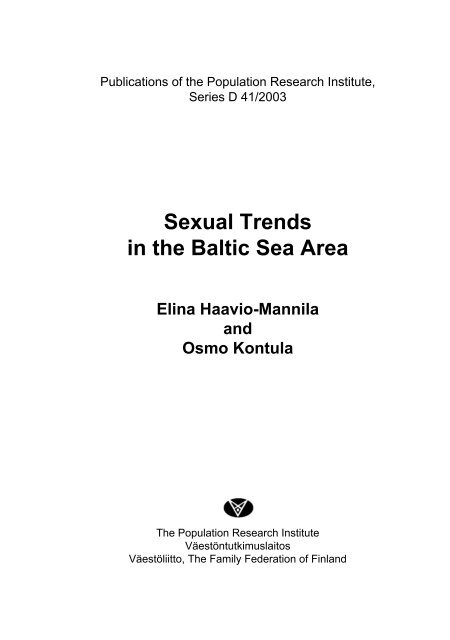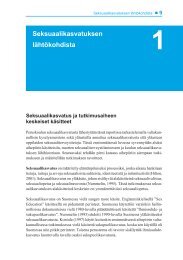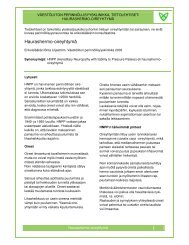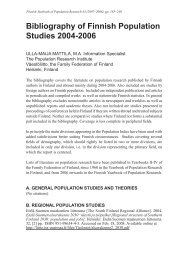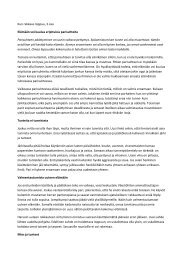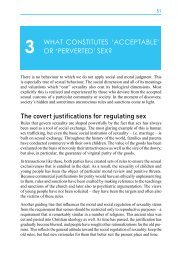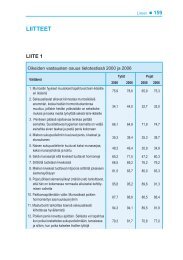New Views on Sexual Health: The Case of Finland - Väestöliitto
New Views on Sexual Health: The Case of Finland - Väestöliitto
New Views on Sexual Health: The Case of Finland - Väestöliitto
You also want an ePaper? Increase the reach of your titles
YUMPU automatically turns print PDFs into web optimized ePapers that Google loves.
Publicati<strong>on</strong>s <strong>of</strong> the Populati<strong>on</strong> Research Institute,Series D 41/2003<strong>Sexual</strong> Trendsin the Baltic Sea AreaElina Haavio-MannilaandOsmo K<strong>on</strong>tula<strong>The</strong> Populati<strong>on</strong> Research InstituteVäestöntutkimuslaitosVäestöliitto, <strong>The</strong> Family Federati<strong>on</strong> <strong>of</strong> <strong>Finland</strong>
<strong>The</strong> cover picture by Sirkka-Liisa L<strong>on</strong>ka,hand-made linen paper, Couple 1992.Translated by Maija MäkinenLayout: Anne Virtanen<strong>The</strong> Populati<strong>on</strong> Research InstituteVäestöntutkimuslaitosVäestöliitto, <strong>The</strong> Family Federati<strong>on</strong> <strong>of</strong> <strong>Finland</strong>PO Box 849 (Iso Roobertinkatu 20–22 A)FIN 00101 Helsinki, <strong>Finland</strong>Teleph<strong>on</strong>e: +358-9-228 050Telefax: +358-9-612 1211E-mail: pop.inst@vaestoliitto.fihttp://www.vaestoliitto.fiISBN 952-9605-99-4ISSN 0357-4725Hakapaino OyHelsinki 2003
C<strong>on</strong>tentsPrologue .............................................................................................................71. Introducti<strong>on</strong>.................................................................................................11Background <strong>on</strong> sexual research.................................................................11Different approaches ........................................................................11Sex and sexuality..............................................................................13<strong>Sexual</strong> generati<strong>on</strong>s............................................................................15Internati<strong>on</strong>al comparis<strong>on</strong>s ................................................................16<strong>The</strong> structure <strong>of</strong> this book.................................................................182. <strong>Sexual</strong> initiati<strong>on</strong> .........................................................................................20Acceptance <strong>of</strong> sexual relati<strong>on</strong>s am<strong>on</strong>g young people ......................20Talking about sex, and teaching young people about sex ................23<strong>The</strong> beginning <strong>of</strong> dating ..................................................................25<strong>The</strong> sexually uninitiated ..................................................................28First time <strong>of</strong> sexual intercourse – at what age? ................................28<strong>The</strong> first sexual partner.....................................................................31Use <strong>of</strong> c<strong>on</strong>tracepti<strong>on</strong> in first sexual intercourse ...............................343. Couple formati<strong>on</strong> and sexual relati<strong>on</strong>ships .......................................37Current forms <strong>of</strong> couple relati<strong>on</strong>ships.......................................................37Marriage, cohabitati<strong>on</strong>, living-apart-together (LAT),and living single ...............................................................................37Love and the couple relati<strong>on</strong>ship......................................................41<strong>Sexual</strong> partners and lifetime relati<strong>on</strong>ships ................................................44Number <strong>of</strong> sexual partners ...............................................................44Loving and sexual relati<strong>on</strong>ships.......................................................51Social factors that c<strong>on</strong>tribute to the number <strong>of</strong> sexual partners .......53Marriage and cohabitati<strong>on</strong>................................................................55Workplace romance..........................................................................58Parallel relati<strong>on</strong>ships ........................................................................60Lifetime relati<strong>on</strong>ship types...............................................................693
Preferred sexual lifestyle...........................................................................72Form and commitment <strong>of</strong> preferred sexual relati<strong>on</strong>ships.................72Preferred types <strong>of</strong> sexual relati<strong>on</strong>ships am<strong>on</strong>gdifferent age groups ..........................................................................74Compatibility <strong>of</strong> preferred and actual sexual lifestyle .....................754. <strong>Sexual</strong> desire ..............................................................................................79Nature <strong>of</strong> sexual desire.....................................................................79Satisfacti<strong>on</strong> with the frequency <strong>of</strong> intercoursein the present couple relati<strong>on</strong>ship.....................................................80Prevalence <strong>of</strong> lack <strong>of</strong> sexual desire ..................................................87Factors that explain lack <strong>of</strong> sexual desire.........................................915. <strong>Sexual</strong> activity ............................................................................................93<strong>Sexual</strong> relati<strong>on</strong>ship with a partner.............................................................93Relati<strong>on</strong>ship to the latest partner .....................................................93Sex with a same-sex partner ............................................................94Discussing sex with a partner ..........................................................99Frequency <strong>of</strong> sexual intercourse.....................................................101Gender roles in initiating intercourse .............................................104Alcohol and sexual intercourse ......................................................107Types <strong>of</strong> sexual expressi<strong>on</strong>......................................................................109Positi<strong>on</strong>s in intercourse ..................................................................110Manual stimulati<strong>on</strong>.........................................................................113Oral sex...........................................................................................116Anal intercourse .............................................................................123B<strong>on</strong>dage and sadomasochism.........................................................124Sex for m<strong>on</strong>ey ................................................................................125Masturbati<strong>on</strong> ...........................................................................................129Autoeroticism and masturbati<strong>on</strong> ....................................................129Fears c<strong>on</strong>nected to masturbati<strong>on</strong> ....................................................131Differences in masturbati<strong>on</strong> frequency ..........................................132Masturbati<strong>on</strong> and the couple relati<strong>on</strong>ship ......................................136Who has the highest motivati<strong>on</strong> to masturbate?.............................137<strong>The</strong> relative significance <strong>of</strong> factors that predict masturbati<strong>on</strong> .......142Use <strong>of</strong> pornography.................................................................................143What is pornography? ....................................................................143More exiting porn, but less <strong>of</strong> it .....................................................144Masturbati<strong>on</strong> and pornography ......................................................151Factors that explain the use <strong>of</strong> porn................................................153Ph<strong>on</strong>e sex........................................................................................1544
6. <strong>Sexual</strong> wellbeing and sexual health ...................................................155Orgasms...................................................................................................155Orgasmic frequency .......................................................................156What increases orgasmic frequency? .............................................160<strong>Sexual</strong> satisfacti<strong>on</strong>...................................................................................162Satisfacti<strong>on</strong> with sexual experiences and couple relati<strong>on</strong>ships......162<strong>Sexual</strong> self-image ...........................................................................167Factors that affect sexual satisfacti<strong>on</strong>.............................................170Problems with sexual arousal and durati<strong>on</strong> <strong>of</strong> sexual intercourse ..........172Erecti<strong>on</strong> dysfuncti<strong>on</strong>.......................................................................173Vaginal lubricati<strong>on</strong> difficulties .......................................................178Timing: when the partner is too quick or too slow.........................181Effect <strong>of</strong> illness <strong>on</strong> sexual relati<strong>on</strong>s................................................184C<strong>on</strong>tracepti<strong>on</strong> ..........................................................................................185Aborti<strong>on</strong> .................................................................................................190<strong>Sexual</strong>ly transmitted diseases (STDs).....................................................1947. <strong>Sexual</strong> trends in the 1990s....................................................................200Summary <strong>of</strong> the implementati<strong>on</strong> <strong>of</strong> the study.........................................200Regi<strong>on</strong>al differences in sexual life..........................................................203Sex in youth....................................................................................203<strong>Sexual</strong> relati<strong>on</strong>ships........................................................................204<strong>Sexual</strong> activity ................................................................................206<strong>Sexual</strong> wellbeing ............................................................................207C<strong>on</strong>tracepti<strong>on</strong> and sexually transmitted diseases ...........................207<strong>Sexual</strong> culture in the east and west .........................................................208Gender similarities and differences ........................................................211Gender similarities .........................................................................211Gender difference similarities in different areas ............................212Internati<strong>on</strong>al variati<strong>on</strong> in gender differences..................................213What are the future sexual trends?..........................................................214References.....................................................................................................222Authors ...........................................................................................................2285
Appendices....................................................................................................229<strong>The</strong> data...................................................................................................229<strong>The</strong> 1971 Finnish study ..................................................................229<strong>The</strong> 1992 Finnish study ..................................................................231<strong>The</strong> 1999 Finnish study ..................................................................234<strong>The</strong> Swedish data for 1996.............................................................236<strong>The</strong> St. Petersburg data for 1996 ....................................................237<strong>The</strong> Est<strong>on</strong>ian data for 2000 ............................................................238Presentati<strong>on</strong> method <strong>of</strong> the findings...............................................239Representativeness <strong>of</strong> the 1999 data set..................................................240Demographics, lifestyle and couple relati<strong>on</strong>ships..........................240Data from retrospective questi<strong>on</strong>s..................................................243Entire life course data.....................................................................245C<strong>on</strong>clusi<strong>on</strong>s regarding the representativeness <strong>of</strong>the 1999 data ..................................................................................248<strong>The</strong> 1999 survey questi<strong>on</strong>naire ...............................................................2536
PrologueIt is thanks to a small group <strong>of</strong> researchers – Kai Sievers, Osmo Koskelainen andKimmo Leppo – and to the nati<strong>on</strong>ally representative data <strong>on</strong> sexual issues that theycollected through interviews as early as 1971, that it has been possible to study thechanges in sexual behavior and values that occurred am<strong>on</strong>g the adult populati<strong>on</strong> in<strong>Finland</strong> during the 20 th century (Sievers, Koskelainen & Leppo, 1974).In the 1990s, we, the authors <strong>of</strong> the present volume, collected two new datasets that are largely comparable to the first sex study. In 1992, the Academy <strong>of</strong><strong>Finland</strong> funded our project to interview and survey 2,250 Finnish participantsaged 18-74 years. <strong>The</strong> study’s findings and the comparis<strong>on</strong>s with the 1971 studywere published as Suomalainen seksi. Tietoa suomalaisten sukupuolielämänmuutoksesta. (Sex in <strong>Finland</strong>: Informati<strong>on</strong> about changes in Finnish sexual life,K<strong>on</strong>tula & Haavio-Mannila, 1993). Central porti<strong>on</strong>s <strong>of</strong> the book were publishedin England as <strong>Sexual</strong> pleasures: Enhancement <strong>of</strong> sex life in <strong>Finland</strong>, 1971–1992(K<strong>on</strong>tula & Haavio-Mannila, 1995a). This volume is also available <strong>on</strong> the web, atwww.sexology.cjb.net.<strong>The</strong> sec<strong>on</strong>d part <strong>of</strong> our so-called FINSEX project was a study <strong>of</strong> sexual topicsas they appear in the media. It was published in Seksiä lehtien sivuilla (Sex <strong>on</strong> thepages <strong>of</strong> magazines, K<strong>on</strong>tula & Kos<strong>on</strong>en, 1994; K<strong>on</strong>tula & Kos<strong>on</strong>en, 1996). <strong>The</strong>aim was to find out how representati<strong>on</strong>s <strong>of</strong> sexuality had changed in the Finnishpress in the course <strong>of</strong> thirty years <strong>on</strong> the basis <strong>of</strong> published texts, images and advertisements.This informati<strong>on</strong> provided a background for the changes in sexuallife that could be observed. This data was used to assess the overall changes thathave occurred in Finnish sexual culture, as well as the timing <strong>of</strong> such changes.<strong>The</strong> third part <strong>of</strong> the larger project c<strong>on</strong>sisted <strong>of</strong> sexual autobiographies thatwere collected in a writing competiti<strong>on</strong> in 1992. On the basis <strong>of</strong> these autobiographies,we published two volumes in Finnish: Matkalla intohimo<strong>on</strong>: Nuoruudenhurma ja kärsimys seksuaalielämäkertojen kuvaamana. (Al<strong>on</strong>g the wayto passi<strong>on</strong>: <strong>The</strong> joy and suffering <strong>of</strong> youth revealed in sexual autobiographies,K<strong>on</strong>tula & Haavio-Mannila, 1995b) and Intohim<strong>on</strong> hetkiä. Seksuaalisen läheisyydenkaipuu ja täyttymys omaelämäkertojen kuvaamana (Moments <strong>of</strong> passi<strong>on</strong>:L<strong>on</strong>ging and fulfillment <strong>of</strong> sexual intimacy described in sexual autobiographies,K<strong>on</strong>tula & Haavio-Mannila, 1997). <strong>The</strong> sexual autobiographies have also yieldedan English-language volume, <strong>Sexual</strong> Lifestyles in the Twentieth Century (Haavio-Mannila, K<strong>on</strong>tula & Rotkirch, 2002). <strong>The</strong> sexual autobiographies have supported7
<strong>Sexual</strong> Trends in the Baltic Sea Areaand provided practical insights into the more pr<strong>of</strong>ound social changes that haveoccurred in sexual life – changes that are also apparent in the results <strong>of</strong> our surveys.We also cooperated with other European researchers in a venture that was financedby the European Uni<strong>on</strong>. <strong>The</strong> aim was to compile the data collected throughnati<strong>on</strong>al surveys about sexual behavior. Apart from the present project, these studieswere financed with funds intended for HIV preventi<strong>on</strong>. Finnish findings wereincluded in a European comparis<strong>on</strong> in a book entitled <strong>Sexual</strong> Behaviour and HIV/AIDS in Europe: Comparis<strong>on</strong>s <strong>of</strong> Nati<strong>on</strong>al Surveys (edited by Michel Hubert,Nathalie Bajos & <strong>The</strong>o Sandfort, 1998). Our c<strong>on</strong>tributi<strong>on</strong>s were also included inthat book.In the late 1990s, European research cooperati<strong>on</strong> (www.fusl.ac.be/Files/General/ces/rechsida.AC2.html) provided <strong>on</strong>e <strong>of</strong> the incentives to begin to collectfollow-up data <strong>on</strong> Finnish sexual lifestyles. <strong>The</strong> Ministry <strong>of</strong> Social Affairsand <strong>Health</strong> in <strong>Finland</strong> supplied the funding. Together with Statistics <strong>Finland</strong>, wecompiled the data in late 1998 and early 1999 in order to compare the resultswith the 1971 and 1992 surveys. <strong>The</strong> internati<strong>on</strong>al comparis<strong>on</strong>s are based <strong>on</strong> thefollowing adult populati<strong>on</strong> survey sets: the survey data collected in 1996 in St.Petersburg through Academy <strong>of</strong> <strong>Finland</strong> funding (Gr<strong>on</strong>ow et al., 1997), the datafrom a nati<strong>on</strong>al interview survey <strong>on</strong> sexual lifestyles c<strong>on</strong>ducted in Sweden in1996 (Lewin et al., 1998), and the survey data from Est<strong>on</strong>ia in 2000 compiled byElina Haavio-Mannila. <strong>Sexual</strong> autobiographies from St. Petersburg and Est<strong>on</strong>ia(Rotkirch, 2000; Karusoo, 1997) also provided indirect support for some <strong>of</strong> ourinterpretati<strong>on</strong>s.<strong>The</strong> present English-language volume is based <strong>on</strong> a more extensive Finnishwork Seksin trendit meillä ja naapureissa (Trends in sex life: At home and in theneighbouring countries) (Haavio-Mannila & K<strong>on</strong>tula, 2001) as well as a statisticalreport Trends in sexual life (Haavio-Mannila, K<strong>on</strong>tula & Kuusi, 2001).This book has two aims. First <strong>of</strong> all, we analyze the changes that occurred inFinnish sexual lifestyles from 1971 to 1992 and 1999. A sexual lifestyle study thathas been repeated three times is unique worldwide. <strong>The</strong> oldest interviewees wereborn in 1917 and the youngest in 1981, and their sexual experiences thus spannearly the entire last century.<strong>The</strong> sec<strong>on</strong>d aim is to compare sexual lifestyles in four cultural areas in the Balticregi<strong>on</strong>: <strong>Finland</strong>, Sweden, Est<strong>on</strong>ia and St. Petersburg. <strong>The</strong> first two representNordic countries, while the latter two represent areas that were part <strong>of</strong> the formerSoviet Uni<strong>on</strong>. A comparis<strong>on</strong> <strong>of</strong> Nordic countries and former Soviet areas illustratesthe impact <strong>of</strong> ec<strong>on</strong>omic, political and cultural factors <strong>on</strong> sexual lifestyle.Each <strong>of</strong> the four areas is geographically adjacent to the Baltic Sea, and the historiesare intertwined in many ways. Each <strong>of</strong> the four areas has its own language,and the ethnic background and culture <strong>of</strong> each regi<strong>on</strong>’s populati<strong>on</strong> is different.8
PrologueWe would like to express our gratitude to the Populati<strong>on</strong> Research Institute<strong>of</strong> the Family Federati<strong>on</strong> <strong>of</strong> <strong>Finland</strong>, and its Director Ismo Söderling, as well asto the Department <strong>of</strong> Sociology <strong>of</strong> the University <strong>of</strong> Helsinki, for providing theessential resources that made it possible to bring forth this book. We would alsolike to thank Statistics <strong>Finland</strong>, and particularly Päivi Hokka, for compiling the1999 data. Additi<strong>on</strong>al thanks to Elina Kuusi for her assistance with the tablesand figures, and to Tapani Alkula for his invaluable assistance in statistical dataprocessing.We would also like to thank our internati<strong>on</strong>al partners. <strong>The</strong> St. Petersburg andEst<strong>on</strong>ia surveys were designed together with Anna Temkina, Elena Zdravomyslova,Anna Rotkirch and Krista Papp. Roman Magilevski and Oleg Dempo from St.Petersburg Gallup, Olli Perheentupa from the Finnish C<strong>on</strong>sulate in St. Petersburg,and Erkki Rannik from the Est<strong>on</strong>ian Academy <strong>of</strong> Sciences participated in the collecti<strong>on</strong><strong>of</strong> the St. Petersburg data. <strong>The</strong> data <strong>on</strong> Est<strong>on</strong>ia was compiled by the Emorresearch center, where Mari Tarum-Seilenthal’s input was invaluable. Thank youto Bo Lewin, who graciously allowed us to use the Swedish data.Since the 1960s, the release <strong>of</strong> data c<strong>on</strong>cerning sexual lifestyles for public usehas c<strong>on</strong>tributed to the happiness <strong>of</strong> people’s relati<strong>on</strong>ships and sexual well-being.In recent years, there has occurred an internati<strong>on</strong>al trend to promote sexual rightsand sexual health (Lottes & K<strong>on</strong>tula, 2000). <strong>Sexual</strong> research and new informati<strong>on</strong>about sex have played an important role in this development. We hope that thenew data in this book will help to promote sexual wellbeing and sexual health alsoin the pers<strong>on</strong>al lives <strong>of</strong> our readers.Helsinki, November 2003Elina Haavio-Mannila and Osmo K<strong>on</strong>tula9


